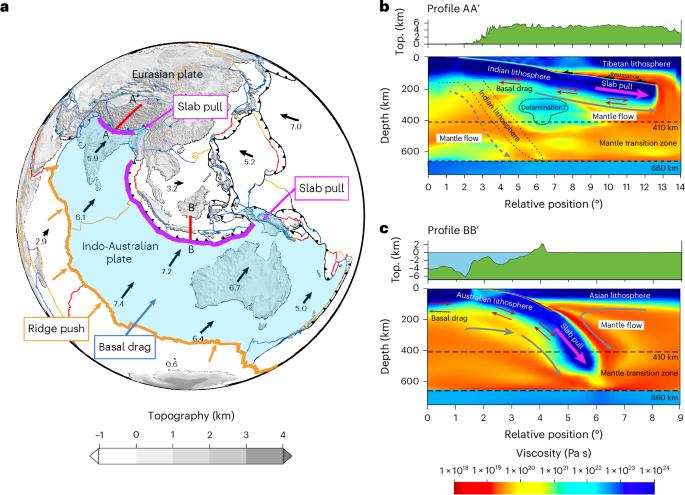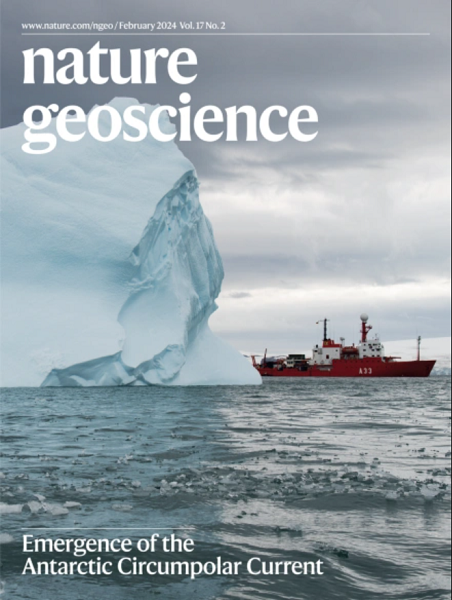Ongoing India–Eurasia collision predominantly driven by Sumatra–Java slab pull
IF 16.1
1区 地球科学
Q1 GEOSCIENCES, MULTIDISCIPLINARY
引用次数: 0
Abstract
Continued India–Eurasia convergence since the early Palaeogene has led to the formation of the Tibetan Plateau. Yet the primary driving mechanisms of this protracted convergence remain debated, limiting our understanding of continental collision dynamics. Here we provide a holistic quantification of various driving forces to this convergence by integrating high-resolution, plate-boundary-resolving global convection models with observational constraints. Whereas different forces can produce the observed plate motion, we show that the primary driving force can be definitively constrained when Indo-Australian intraplate stress and strain rates are used as constraints in addition to plate motions. Specifically, we identify that the position of the transition in stress orientation within the Indo-Australian plate is highly sensitive to the relative strength of plate-boundary forces. When the plate motion and this stress-orientation transition are fit simultaneously, we find slab pull from Sumatra–Java subduction is the predominant driving force of India–Eurasia convergence with continental collision exerting an overall resisting force and rule out mantle basal drag playing more than a secondary role. We suggest slab pull from adjacent subduction zones has been the primary driver of the uplift of the Tibetan Plateau since its onset and so this may be an exceptional event in Earth’s history. The main driving force for the continuing India–Eurasia collision is slab pull from the adjacent Sunda subduction zone, according to global geodynamic simulations constrained by observations including the Indo-Australian intraplate stress distribution.

正在进行的印度-欧亚大陆碰撞主要由苏门答腊-爪哇板块拉力驱动
然而,这种长期趋同的主要驱动机制仍然存在争议,限制了我们对大陆碰撞动力学的理解。在这里,我们通过整合具有观测约束的高分辨率、板块边界解析的全球对流模型,对这种收敛的各种驱动力进行了全面量化。虽然不同的力可以产生观察到的板块运动,但我们表明,当印度-澳大利亚板内应力和应变率被用作除板块运动外的约束时,主要驱动力可以明确地受到约束。具体来说,我们发现印澳板块内应力方向转变的位置对板块边界力的相对强度高度敏感。当板块运动与这种应力-取向转变同时吻合时,我们发现苏门答腊-爪哇俯冲的板块拉拔是印度-欧亚辐合的主要驱动力,大陆碰撞对印度-欧亚辐合起整体的阻力作用,排除了地幔基底阻力的次要作用。根据包括印澳板块内应力分布在内的全球地球动力学模拟,印度-欧亚大陆持续碰撞的主要驱动力是来自邻近巽他俯冲带的板块拉力。
本文章由计算机程序翻译,如有差异,请以英文原文为准。
求助全文
约1分钟内获得全文
求助全文
来源期刊

Nature Geoscience
地学-地球科学综合
CiteScore
26.70
自引率
1.60%
发文量
187
审稿时长
3.3 months
期刊介绍:
Nature Geoscience is a monthly interdisciplinary journal that gathers top-tier research spanning Earth Sciences and related fields.
The journal covers all geoscience disciplines, including fieldwork, modeling, and theoretical studies.
Topics include atmospheric science, biogeochemistry, climate science, geobiology, geochemistry, geoinformatics, remote sensing, geology, geomagnetism, paleomagnetism, geomorphology, geophysics, glaciology, hydrology, limnology, mineralogy, oceanography, paleontology, paleoclimatology, paleoceanography, petrology, planetary science, seismology, space physics, tectonics, and volcanology.
Nature Geoscience upholds its commitment to publishing significant, high-quality Earth Sciences research through fair, rapid, and rigorous peer review, overseen by a team of full-time professional editors.
 求助内容:
求助内容: 应助结果提醒方式:
应助结果提醒方式:


